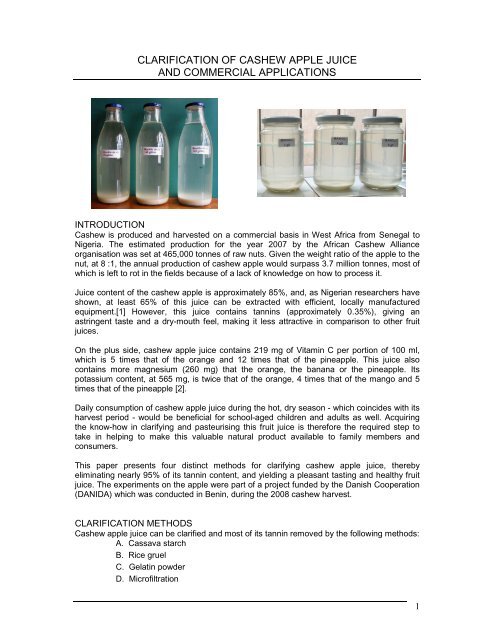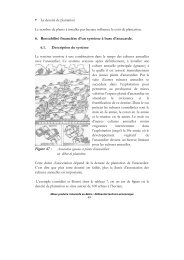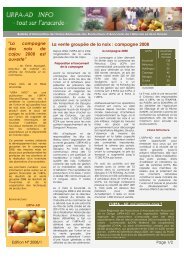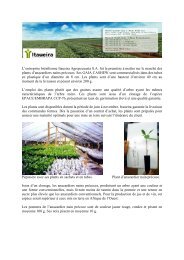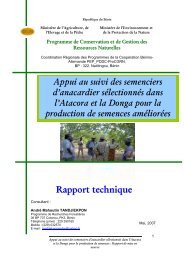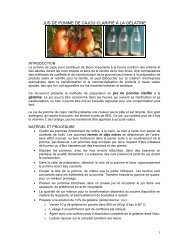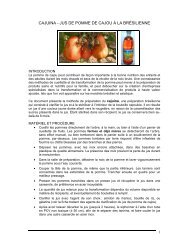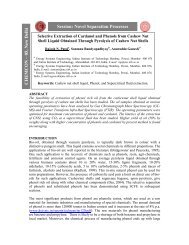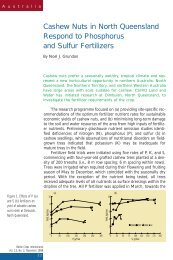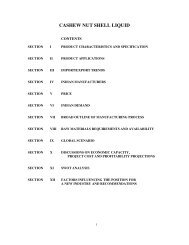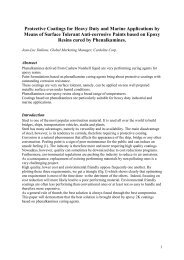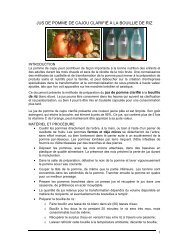Clarification and Microfiltration of Cashew Apple Juice
Clarification and Microfiltration of Cashew Apple Juice
Clarification and Microfiltration of Cashew Apple Juice
You also want an ePaper? Increase the reach of your titles
YUMPU automatically turns print PDFs into web optimized ePapers that Google loves.
CLARIFICATION OF CASHEW APPLE JUICE<br />
AND COMMERCIAL APPLICATIONS<br />
INTRODUCTION<br />
<strong>Cashew</strong> is produced <strong>and</strong> harvested on a commercial basis in West Africa from Senegal to<br />
Nigeria. The estimated production for the year 2007 by the African <strong>Cashew</strong> Alliance<br />
organisation was set at 465,000 tonnes <strong>of</strong> raw nuts. Given the weight ratio <strong>of</strong> the apple to the<br />
nut, at 8 :1, the annual production <strong>of</strong> cashew apple would surpass 3.7 million tonnes, most <strong>of</strong><br />
which is left to rot in the fields because <strong>of</strong> a lack <strong>of</strong> knowledge on how to process it.<br />
<strong>Juice</strong> content <strong>of</strong> the cashew apple is approximately 85%, <strong>and</strong>, as Nigerian researchers have<br />
shown, at least 65% <strong>of</strong> this juice can be extracted with efficient, locally manufactured<br />
equipment.[1] However, this juice contains tannins (approximately 0.35%), giving an<br />
astringent taste <strong>and</strong> a dry-mouth feel, making it less attractive in comparison to other fruit<br />
juices.<br />
On the plus side, cashew apple juice contains 219 mg <strong>of</strong> Vitamin C per portion <strong>of</strong> 100 ml,<br />
which is 5 times that <strong>of</strong> the orange <strong>and</strong> 12 times that <strong>of</strong> the pineapple. This juice also<br />
contains more magnesium (260 mg) that the orange, the banana or the pineapple. Its<br />
potassium content, at 565 mg, is twice that <strong>of</strong> the orange, 4 times that <strong>of</strong> the mango <strong>and</strong> 5<br />
times that <strong>of</strong> the pineapple [2].<br />
Daily consumption <strong>of</strong> cashew apple juice during the hot, dry season - which coincides with its<br />
harvest period - would be beneficial for school-aged children <strong>and</strong> adults as well. Acquiring<br />
the know-how in clarifying <strong>and</strong> pasteurising this fruit juice is therefore the required step to<br />
take in helping to make this valuable natural product available to family members <strong>and</strong><br />
consumers.<br />
This paper presents four distinct methods for clarifying cashew apple juice, thereby<br />
eliminating nearly 95% <strong>of</strong> its tannin content, <strong>and</strong> yielding a pleasant tasting <strong>and</strong> healthy fruit<br />
juice. The experiments on the apple were part <strong>of</strong> a project funded by the Danish Cooperation<br />
(DANIDA) which was conducted in Benin, during the 2008 cashew harvest.<br />
CLARIFICATION METHODS<br />
<strong>Cashew</strong> apple juice can be clarified <strong>and</strong> most <strong>of</strong> its tannin removed by the following methods:<br />
A. Cassava starch<br />
B. Rice gruel<br />
C. Gelatin powder<br />
D. <strong>Micr<strong>of</strong>iltration</strong><br />
1
A. Cassava starch<br />
Indian researchers have demonstrated the effectiveness <strong>of</strong> common cassava starch in<br />
clarifying cashew apple juice [3]. This clarifying agent can be found in most open markets in<br />
West Africa. High quality cassava starch is sold in a fine, clean, white powder form.<br />
The preparation steps for a solution <strong>of</strong> cassava starch are as follows:<br />
• Bring to boil 100 ml <strong>of</strong> water (equivalent to 100 g on a weight scale);<br />
• Pour the boiling water in a small jar (fruit preservative jar, or olive jar);<br />
• Slowly mix 20 g <strong>of</strong> cassava starch into the hot water, stirring vigorously;<br />
• With the starch in agitation, cover the jar with the lid <strong>and</strong> shake vigorously until the<br />
solution is completely dissolved (to protect the h<strong>and</strong> from burns, use an oven mitten);<br />
To clarify the cashew apple juice:<br />
• Pour the juice in a measured container : preferably a stainless steel vessel;<br />
• With the juice stirred in a circular motion, pour 4 g <strong>of</strong> the prepared cassava solution<br />
for each litre <strong>of</strong> raw juice to be clarified;<br />
• Continue stirring for 5 minutes until the solution is well mixed with the juice;<br />
• Leave the juice to rest until the tannins settle at the bottom <strong>of</strong> the vessel. At this time,<br />
the vessel should be covered. <strong>Clarification</strong> could take upwards <strong>of</strong> an hour, depending<br />
on the period <strong>of</strong> harvest;<br />
• Using a food-grade PCV tubing (± 50 cm) siphon the clarified juice into another<br />
stainless steel vessel.<br />
The next step is to pasteurise the clarified juice to destroy micro-organisms <strong>and</strong> wild yeast<br />
that will spoil the juice. Brazilian researchers [4] recommend the following steps:<br />
• With the clarified juice in a stainless steel vessel, stir constantly, <strong>and</strong> heat until a<br />
temperature <strong>of</strong> 85 o C is reached for 20 seconds;<br />
• If the bottom <strong>of</strong> the stainless steel vessel is very thin, it is strongly suggested that<br />
some distance (10 cm) be kept between the flame <strong>and</strong> the vessel, to prevent the juice<br />
from acquiring a burnt odour.<br />
• Remove from heat <strong>and</strong> allow the juice to cool down.<br />
The clarified cashew apple juice can then be refrigerated <strong>and</strong> kept for a good three days.<br />
Otherwise, if kept at room temperature (± 30 o C), it should be consumed within 24 hours, in<br />
order to prevent fermentation from occurring.<br />
It should be noted that cassava starch can prove to be unpredictable in its clarification <strong>of</strong><br />
cashew apple juice. In lab experiments conducted on the clarifying agents, in Benin, during<br />
the harvest <strong>of</strong> 2008, the effectiveness <strong>of</strong> cassava starch decreased as the harvest season<br />
entered into its second half period. In some instances, clarification took as much as 8 hours,<br />
<strong>and</strong> refrigeration <strong>of</strong> the juice was required to speed up the process.<br />
For this reason, <strong>and</strong> more so if juice processing is attempted on a small-scale, commercial<br />
basis, it is recommended that regular dosage testing be conducted to better determine the<br />
ideal values <strong>and</strong> durations to be used. For example, instead <strong>of</strong> using 20 g <strong>of</strong> cassava starch,<br />
a strong solution: 30 g, might be used. For the dissolved solution, one might try 6 g <strong>of</strong><br />
cassava solution instead <strong>of</strong> 4 g.<br />
2
Dosage test, in 33cl jars : 3 g/litre, 4 g/litre <strong>and</strong> 5 g/litre.<br />
In the above example, three small jars <strong>of</strong> 33cl each were used to determine the ideal<br />
cassava starch solution strength. Visual clarity <strong>and</strong> speed <strong>of</strong> tannin precipitation are key<br />
criteria in the selection <strong>of</strong> the solution strength.<br />
B. Rice gruel<br />
Rice gruel as a clarifying agent for raw cashew apple juice is another contribution <strong>of</strong> Indian<br />
research scientists. Of the three agents discussed, rice gruel is the quickest way to obtain<br />
clear cashew apple juice - with the simplest <strong>of</strong> means: residual water from the cooking <strong>of</strong><br />
rice.<br />
The preparation steps for a rice gruel solution are as follows:<br />
• One cup <strong>of</strong> white rice, preferably parboiled rice;<br />
• Six cups <strong>of</strong> water (about 3 times the conventional amount);<br />
• Bring the water to a boil;<br />
• Pour the rice in the boiling water, mix well, <strong>and</strong> then reduce to low heat;<br />
• Cook on low heat for 20 to 25 minutes; no salt added;<br />
• Remove casserole from heat;<br />
• Pour the rice <strong>and</strong> water into a strainer, or sieve, <strong>and</strong> retain the water; the water is the<br />
rice gruel;<br />
• Allow the gruel to cool down;<br />
• With the raw juice in a stainless steel vessel <strong>and</strong> the juice stirred in a circular motion,<br />
slowly pour 125 ml <strong>of</strong> rice gruel for every litre <strong>of</strong> juice to be clarified;<br />
• Stir constantly for about 5 minutes for a thorough blend <strong>of</strong> juice <strong>and</strong> solution;<br />
• Leave the juice to rest until the tannins settle at the bottom <strong>of</strong> the vessel. At this time,<br />
the vessel should be covered.<br />
Rice gruel is a very effective clarifying agent when applied to cashew apple juice. Within<br />
seconds <strong>of</strong> pouring the solution into the juice, a chemical reaction is clearly visible.<br />
Precipitation <strong>of</strong> the tannins should be achieved within 20 to 40 minutes. In contrast to the<br />
cassava starch’s action, rice gruel clarifies the juice by flocculation, that is to say the<br />
formation <strong>of</strong> small loosely aggregated white mass <strong>of</strong> tannins.<br />
Although rice gruel can be effective in clarifying raw cashew apple juice, its efficiency is not<br />
perfect. Adding 125 ml <strong>of</strong> rice gruel to a litre <strong>of</strong> juice is in fact diluting that juice to the tune <strong>of</strong><br />
12.5%. Some discriminating tasters could <strong>of</strong>fer the comment that the juice is not pure.<br />
The image provided below shows how 1-litre bottles can be used either as vessels for<br />
dosage testing, or for clarification once the dosage is determined. The bottles’ vertical<br />
orientation allow for easier siphoning <strong>of</strong> the clarified juice into another vessel.<br />
3
Getting back to the rice used to produce the gruel, it is still edible, although it will appear<br />
quite soggy. Leaving the casserole uncovered for several minutes should allow the extra<br />
moisture to evaporate, <strong>and</strong> the rice could be consumed during the next meal.<br />
It should be mentioned that locally produced rice (not parboiled rice) was used during the<br />
experiments. This trial was unsuccessful because rice that is not parboiled will dissolve in<br />
this excessive amount <strong>of</strong> water <strong>and</strong> slightly longer cooking times. The result is a gruel that<br />
will contain dissolved rice <strong>and</strong> that will alter the taste <strong>of</strong> the clarified apple juice. In lieu <strong>of</strong><br />
locally produced rice, some good quality, generic Asian parboiled rice was successfully used.<br />
The recommended procedure for pasteurising clarified apple juice with rice gruel is the same<br />
as described in section A, where cassava starch was used.<br />
C. Gelatin powder<br />
Gelatin, in powder form, is probably the first clarifying agent that was successfully used to<br />
eliminate the tannins from cashew apple juice. Indian research papers dating back to the<br />
1970s list gelatin, as well as Polyvinyl pyrrolidone (PVP) as efficient clarifying agents.<br />
However, the experiments carried out in Benin did not include PVP because <strong>of</strong> its relative<br />
inaccessibility on the market.<br />
In powder form, gelatin is more readily available in urban markets, either through<br />
supermarkets, wholesalers or lab equipment retailers, among others. Because <strong>of</strong> the small<br />
amount necessary to clarify a litre <strong>of</strong> apple juice, large quantities <strong>of</strong> gelatin would not be a<br />
requirement. In some cities, gelatin in powder form, as seen in the image below, can be<br />
purchased in beer <strong>and</strong> wine stores.<br />
Regarding the amount <strong>of</strong> gelatin required for the preparation <strong>of</strong> an effective solution, there<br />
doesn’t seem to be a consensus among the researchers working on cashew apple juice.<br />
4
Whereas Indian researchers recommend a 5% solution, Brazilian scientists agree on a 10%<br />
solution. In the context <strong>of</strong> the experimental trials in Benin, a 10% gelatin solution was used.<br />
The preparation steps for a gelatin solution are as follows:<br />
• 10 g <strong>of</strong> gelatin powder;<br />
• 90 g <strong>of</strong> water at 60 o C;<br />
• Transfer the hot water into a small jar (a fruit preservative jar, or an olive jar);<br />
• Slowly pour the gelatin into the jar, with the water already in a circular motion;<br />
• Stir the solution with a spoon until the gelatin is completely dissolved; it may be<br />
necessary to use a second spoon to remove the gelatin stuck on the first spoon;<br />
• Allow the dissolved solution to st<strong>and</strong> for one hour;<br />
• With the raw juice in a stainless steel vessel <strong>and</strong> the juice stirred in a circular motion,<br />
slowly pour 2.5 g <strong>of</strong> the gelatin solution for every litre <strong>of</strong> juice to be clarified;<br />
• Continue stirring with a large spoon for 15 minutes to allow the solution <strong>and</strong> the juice<br />
to blend thoroughly;<br />
• Leave the juice to rest until the tannins settle at the bottom <strong>of</strong> the vessel. At this time,<br />
the vessel should be covered.<br />
An efficient gelatin solution should initiate the clarification process upon contact with the raw<br />
juice. Gelatin clarifies the juice by flocculating the tannins, which gradually make their way to<br />
the bottom <strong>of</strong> the vessel. The process normally takes no more than 60 minutes. However,<br />
gelatin as a clarifying agent has also proven to be unpredictable at times, especially during<br />
the second half <strong>of</strong> the harvest period (end <strong>of</strong> February till end <strong>of</strong> March, in Benin).<br />
Inefficient clarification <strong>of</strong> cashew apple juice can manifest itself in several ways: the<br />
precipitation takes longer to accomplish, or, once the precipitation <strong>of</strong> tannins seems almost<br />
complete, the tannins actually begin to rise to the top <strong>of</strong> the vessel. It therefore becomes<br />
essential to document the process carefully as the harvest period advances, <strong>and</strong> also to vary<br />
the dosage, as well as the timeframe for the clarification process. For example, if 2.5 g <strong>of</strong><br />
gelatin were used early on, subsequent trials could use 2 g <strong>of</strong> gelatin, or even 3 grams.<br />
As was stated earlier, none <strong>of</strong> the three clarifying agents discussed achieve 100% efficiency<br />
in clarifying raw cashew apple juice. In a Canadian laboratory study, commissioned by the<br />
Ho Chi Minh University, in Vietnam, gelatin achieved a success rate <strong>of</strong> 94,5% [5] in<br />
eliminating the tannins. No comparable rates are available for the other two agents. That<br />
being said, this rate <strong>of</strong> success is largely sufficient to remove all discernable astringent taste<br />
from the juice, especially for those wishing to enjoy this juice as a fresh, healthy beverage.<br />
The recommended procedure for pasteurising clarified apple juice with gelatin is the same as<br />
described in section A, where cassava starch was used.<br />
Having thus clarified cashew apple juice with one <strong>of</strong> the three agents discussed, one<br />
challenge still remains: to stabilize the juice once pasteurised <strong>and</strong> bottled – beyond 30 days.<br />
<strong>Juice</strong> that has been successfully clarified with one <strong>of</strong> the agents discussed above may still<br />
contain minute amounts <strong>of</strong> tannins which take time to aggregate <strong>and</strong> gradually settle to the<br />
bottom <strong>of</strong> a capped bottle. For many customers, a thin coating <strong>of</strong> white powder on the bottom<br />
<strong>of</strong> a bottle <strong>of</strong> otherwise clear juice can be repulsive. Most customers may not purchase this<br />
juice for fear that it is not pure, nor safe to drink.<br />
For persons interested in producing <strong>and</strong> marketing bottled cashew apple juice, one additional<br />
step is required – a step that researchers agree is the definitive step: micr<strong>of</strong>iltration.<br />
5
D. <strong>Micr<strong>of</strong>iltration</strong><br />
<strong>Micr<strong>of</strong>iltration</strong> is viewed as the ultimate step to take in obtaining clarification <strong>of</strong> cashew apple<br />
juice. A team <strong>of</strong> Brazilian <strong>and</strong> French scientists claim to have obtained «completely clarified<br />
juice» with a combination <strong>of</strong> micr<strong>of</strong>iltration, using membranes with an average pore diameter<br />
<strong>of</strong> 0.1 <strong>and</strong> 0.2 micron, <strong>and</strong> an enzymatic liquefaction pre-treatment.[6]<br />
This research paper also stated that the enzymatic pre-treatment improved the filtration yield<br />
by 30% to 60%. Using tannase or celullase enzymes as a pre-treatment could be considered<br />
the equivalent <strong>of</strong> using cassava starch, rice gruel, or gelatin, in our experiments. Sourcing<br />
enzymes in West Africa could prove to be a challenge, whereas the simpler clarifying agents<br />
are more readily available, <strong>and</strong> affordable.<br />
Using clarifying agents prior to micr<strong>of</strong>iltration is also a pragmatic step to take. Given the<br />
relatively high tannin content (0.35%) <strong>of</strong> raw juice, it is obvious that the ultra thin membranes<br />
would be quickly blocked, or clogged, <strong>and</strong> rendered useless as a second step for<br />
clarification.<br />
The wine industry is the place to look for low-volume <strong>and</strong> semi-industrial micr<strong>of</strong>iltration<br />
systems adaptable to cashew apple juice clarification. Several systems, advertised on the<br />
internet, are presented below. The image on the left shows a hollow fibre module <strong>of</strong><br />
polyethersulfone with pore diameter <strong>of</strong> 0.2 micron. An essential element <strong>of</strong> this system is a<br />
small pressure pump designed to move the juice through the module. On the right, a smallscale<br />
micr<strong>of</strong>iltration system comprised <strong>of</strong> flat sheet filters <strong>and</strong> a pressure pump. This<br />
inexpensive system can filter down to 0.2 micron at a capacity <strong>of</strong> 150 litres per hour.<br />
Image on the left: Microdyn-Nadir.<br />
This <strong>and</strong> other suppliers:<br />
microdyn.com; sartorius.com; sterlitech.com<br />
Image on the right: Sovitec, France. Retail price:<br />
275 €, in 2008, duty free.<br />
Internet address:<br />
http://commerce.ciel.com/sovitec/defaultsgx.asp<br />
In daily usage, some hollow filters on the market have the advantage <strong>of</strong> being washable,<br />
therefore <strong>of</strong>fering potential savings over the flat sheet filters that are discarded after a single<br />
use. This suggests, <strong>of</strong> course, that entrepreneurs wishing to set up an integrated system for<br />
the processing <strong>and</strong> marketing <strong>of</strong> cashew apple juice need to consider several factors before<br />
choosing key elements <strong>of</strong> that system.<br />
6
Two other systems worthy <strong>of</strong> mention are shown below. The image on the left shows a tabletop<br />
system that has features for either the household or the small-scale producer. The<br />
system on the right would be more suitable for semi-industrial applications. Both use flat<br />
sheet filter pads. Entrepreneurs wishing to filter down to 0.2 micron could purchase filter<br />
pads from other sources (ex: Sovitec), since the manufacturer <strong>of</strong> these two systems, Buon<br />
Vino, supplies filter pads at 0,5 micron pore diameter only.<br />
MiniJet micr<strong>of</strong>iltration system. Capacity: 80<br />
litres per hour, filtering at 0.5 micron.<br />
Internet address: www.buonvino.com<br />
Semi-industrial micr<strong>of</strong>iltration system.<br />
Capacity: 350 litres per hour at 0.5 micron.<br />
COMMERCIAL APPLICATIONS<br />
Given the considerable abundance <strong>of</strong> cashew apples in West African countries, <strong>and</strong><br />
considering the highly nutritious content <strong>of</strong> its fresh juice, <strong>and</strong> taking into account the known,<br />
successful technologies to process it, it is now possible to envisage commercial applications<br />
<strong>of</strong> this natural product in this region. Using a combination <strong>of</strong> treatment processes,<br />
entrepreneurs can now set their sights on small-scale, or semi-industrial processing <strong>and</strong><br />
marketing <strong>of</strong> clarified cashew apple juice for urban <strong>and</strong> regional markets.<br />
The current leaders in processing <strong>and</strong> marketing <strong>of</strong> cashew apple juice are, without a doubt,<br />
Brazilian. The have developed commercial processes to bottle pure juice, mixed juices <strong>and</strong><br />
Cajuina (as shown on the image below, on the left). This juice calls for the pasteurisation <strong>of</strong><br />
clarified juice inside the capped, <strong>and</strong> fully immersed bottle - for 2 hours. The result is a darker<br />
juice, with a sweeter taste due to the caramelisation <strong>of</strong> sugars during this long process.<br />
Vitamin C is not eliminated by this process, however (an internet source for this process is<br />
included in the bibliography section). [7]<br />
7
Other commercial applications for cashew apple juice in the foreseeable future are juice<br />
concentrate <strong>and</strong> cashew apple powder (CAP). Given its exceptionally high content <strong>of</strong> Vitamin<br />
C <strong>and</strong> its comparatively higher content <strong>of</strong> Vitamin A, Magnesium <strong>and</strong> Potassium, with respect<br />
to the orange, for example, one can expect that this juice will eventually be considered as the<br />
next exotic ingredient in Energy drinks, or Sports drinks.<br />
Currently, in West African countries, at least half a dozen Energy Drinks are available on the<br />
retail market – at a retail cost <strong>of</strong> 3 to 4 times that <strong>of</strong> regular, bottled fruit juice. This high<br />
margin item is without a doubt even more popular in Western Europe <strong>and</strong> the Americas.<br />
Given the ever-increasing efforts <strong>of</strong> manufacturers to supply markets with new <strong>and</strong> exotic<br />
fruit flavours, one can foresee their enthusiasm for secured supplies <strong>of</strong> juice concentrate or<br />
cashew apple powder.<br />
The technologies involved in producing those two Energy Drink ingredients are again known,<br />
<strong>and</strong> sourceable on internet business (B2B) portals. Of those two ingredients, cashew apple<br />
powder would have the advantage <strong>of</strong> lower shipping cost out <strong>of</strong> Africa, hence a possibly<br />
more pr<strong>of</strong>itable venture for West African producer-suppliers.<br />
CONCLUSION<br />
<strong>Cashew</strong> apple juice, being the highly nutritious food product that it is, merits closer attention<br />
because <strong>of</strong> its health obvious benefits <strong>and</strong> its economic potential for farmers, entrepreneurs<br />
<strong>and</strong> consumers. Given the annual tonnage <strong>of</strong> apples produced in West Africa – more than 3<br />
million tonnes – it is vital that entrepreneurs, government <strong>of</strong>ficials <strong>and</strong> international<br />
development organisations begin working to put an end to this wastage <strong>and</strong> make this<br />
natural product available to families <strong>and</strong> consumers.<br />
As discussed <strong>and</strong> demonstrated in this paper, cashew apple juice can be successfully<br />
clarified at the household level, for a highly-nutritious juice during the dry season, or at a<br />
commercial level for supplying urban <strong>and</strong> regional markets. Efforts at both levels will result in<br />
new value added to the cashew supply chain.<br />
______________<br />
Roméo CORMIER<br />
Marketing Advisor<br />
Oxfam Québec<br />
Benin, West Africa<br />
September, 2008<br />
8
NOTES ON THE EXPERIMENTAL PROJECT<br />
The cashew apple juice products referenced in this paper were the result <strong>of</strong> a three-month project<br />
designed to test the effectiveness <strong>of</strong> simple, but relatively unknown processes for clarifying the juice,<br />
thus eliminating most <strong>of</strong> its high tannin content <strong>and</strong> its astringent taste.<br />
The project was financed by the Danish Cooperation (DANIDA), <strong>and</strong> its promoter was the National<br />
Federation <strong>of</strong> <strong>Cashew</strong> Producers <strong>of</strong> Benin (FENAPAB).<br />
The image below shows samples <strong>of</strong> bottled cashew apple juice which have been clarified<br />
using rice gruel, gelatin (mixed apples <strong>and</strong> yellow apples only), cassava starch, <strong>and</strong> Cajuina<br />
(on the far right).<br />
The experiments, inspired by Indian <strong>and</strong> Brazilian research publications, were carried out in Parakou,<br />
a major cashew production region. The work was carried out by:<br />
Pr<strong>of</strong>essor Joseph DOSSOU, Université d’Abomey-Calavi; jokdossou@yahoo.fr<br />
Paul BONI, agronomer, Department <strong>of</strong> Agriculture; abipaolo2002@yahoo.fr<br />
Roméo CORMIER, Marketing Advisor, Oxfam-Québec; romeo.cormier@gmail.com<br />
REFERENCES<br />
[1] ODUWOLE, O. et al. Economic evaluation <strong>of</strong> a locally fabricated extraction machine for<br />
a cottage cashew juice factory. Journal <strong>of</strong> Food Technology in Africa. Vol 6, N o 1, 2001.<br />
[2] USDA – United States Department <strong>of</strong> Agriculture. Nutrition Database for St<strong>and</strong>ard<br />
Reference. Washington. 2002.<br />
[3] Kerala Agricultural University. 2002. Package <strong>of</strong> Practices Recommendations: Crops.<br />
12th Edition.<br />
[4] CAJUNOR. Applicaçaões de caju – Suco integral de caju. Brasil.2006. Internet address:<br />
http://www.cajunor.com.br.<br />
[5] CRDI – Centre de Recherche pour le Développement International. Étude sur la<br />
clarification du jus de cajou. Ottawa. Canada. 1996.<br />
[6] Fern<strong>and</strong>o Abreu, Ana Mercedes Perez, Manuel Dornier, <strong>and</strong> Max Reynes. Potentialités<br />
de la micr<strong>of</strong>iltration tangentielle sur membranes minérales pour la clarification du jus de<br />
pomme de cajou. CIRAD, France, 2005.<br />
[7] CAJUNOR. Aplicações do caju – Cajuína. Internet address: http://www.cajunor.com.br/<br />
9


